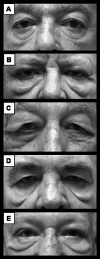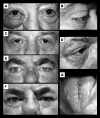Eyelid edema
- PMID: 20567653
- PMCID: PMC2884828
- DOI: 10.1055/s-2007-967744
Eyelid edema
Abstract
Facial aesthetic surgeons are sometimes challenged by the predicament of diagnosing and managing patients with chronic eyelid edema. Herein we provide a brief review of some of the more common causes of pre- and postoperative eyelid edema, many of which have important systemic implications, and offer management suggestions.
Keywords: Periorbital; edema; eyelid.
Figures



References
-
- Stone D U, Chodosh J. Ocular rosacea: an update on pathogenesis and therapy. Curr Opin Ophthalmol. 2004;15:499–502. - PubMed
-
- Diaz C, O'Callaghan C J, Khan A, Ilchyshyn A. Rosacea: a cutaneous marker of Helicobacter pylori infection? Acta Derm Venereol. 2003;83:282–286. - PubMed
-
- Millikan L E. Rosacea as an inflammatory disorder: a unifying theory? Cutis. 2004;73(suppl 1):5–8. - PubMed
-
- Dahl M V, Ross A J, Schlievert P M. Temperature regulates bacterial protein production: possible role in rosacea. J Am Acad Dermatol. 2004;50:266–272. - PubMed
LinkOut - more resources
Full Text Sources
Other Literature Sources

